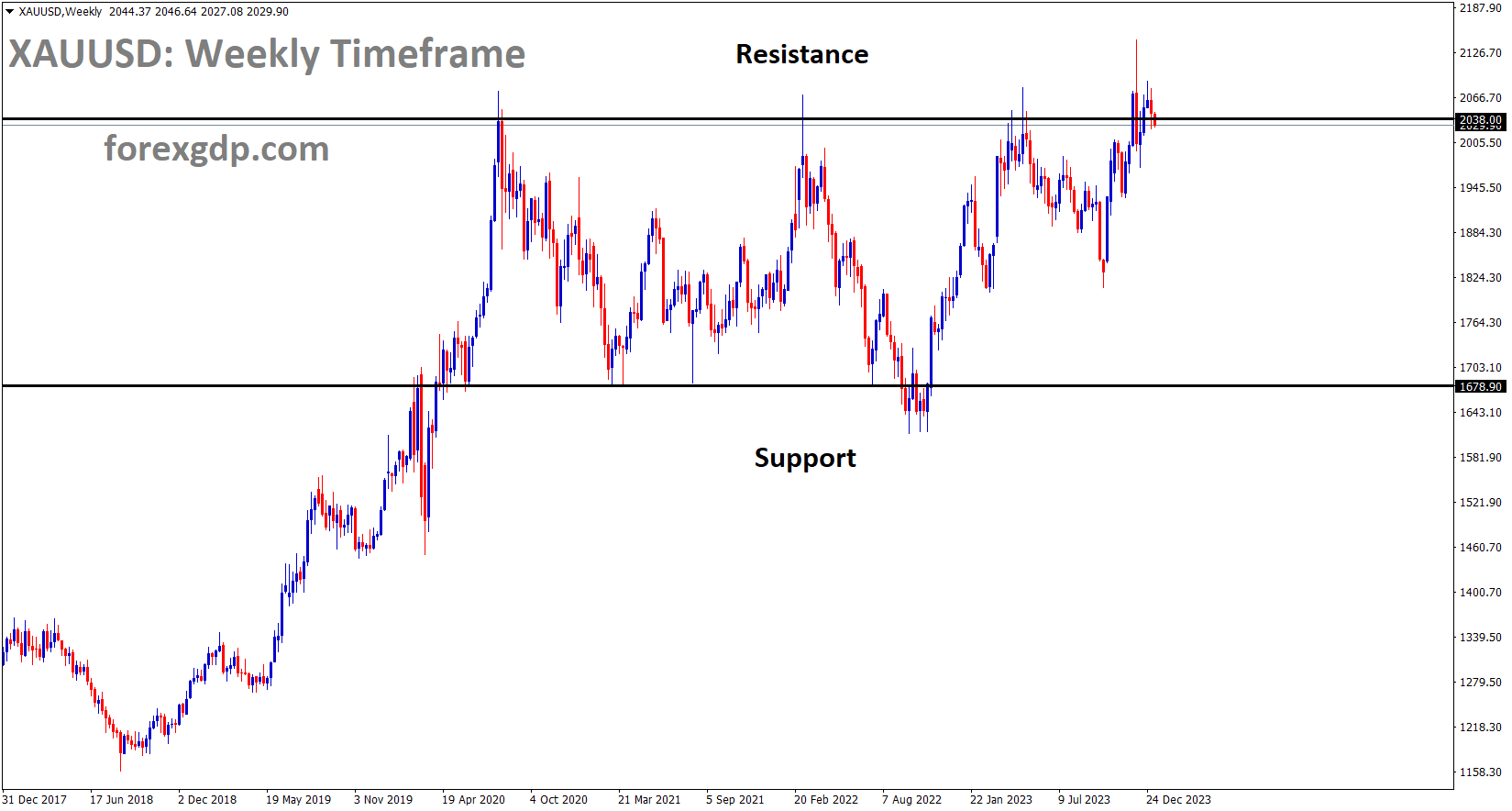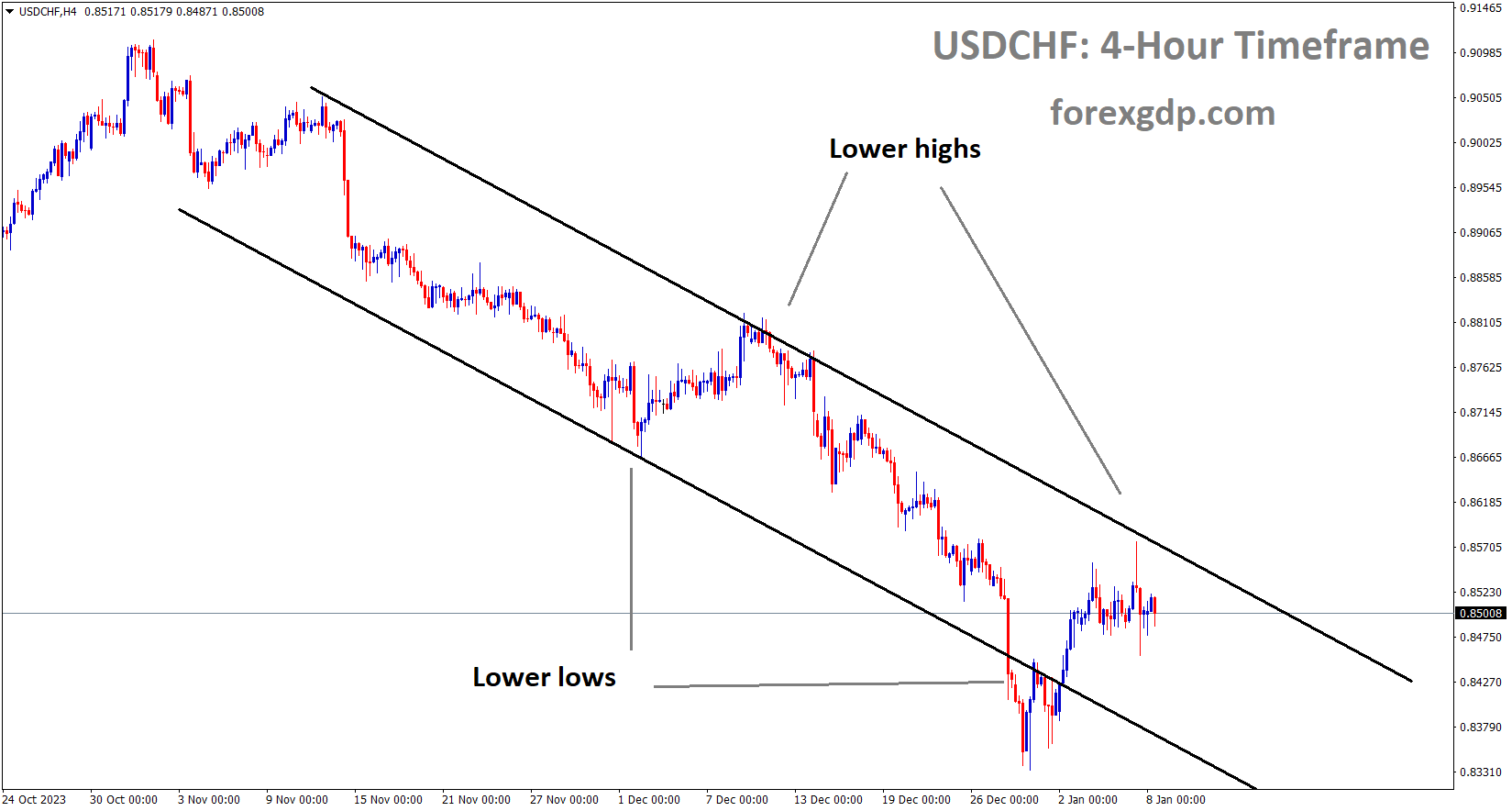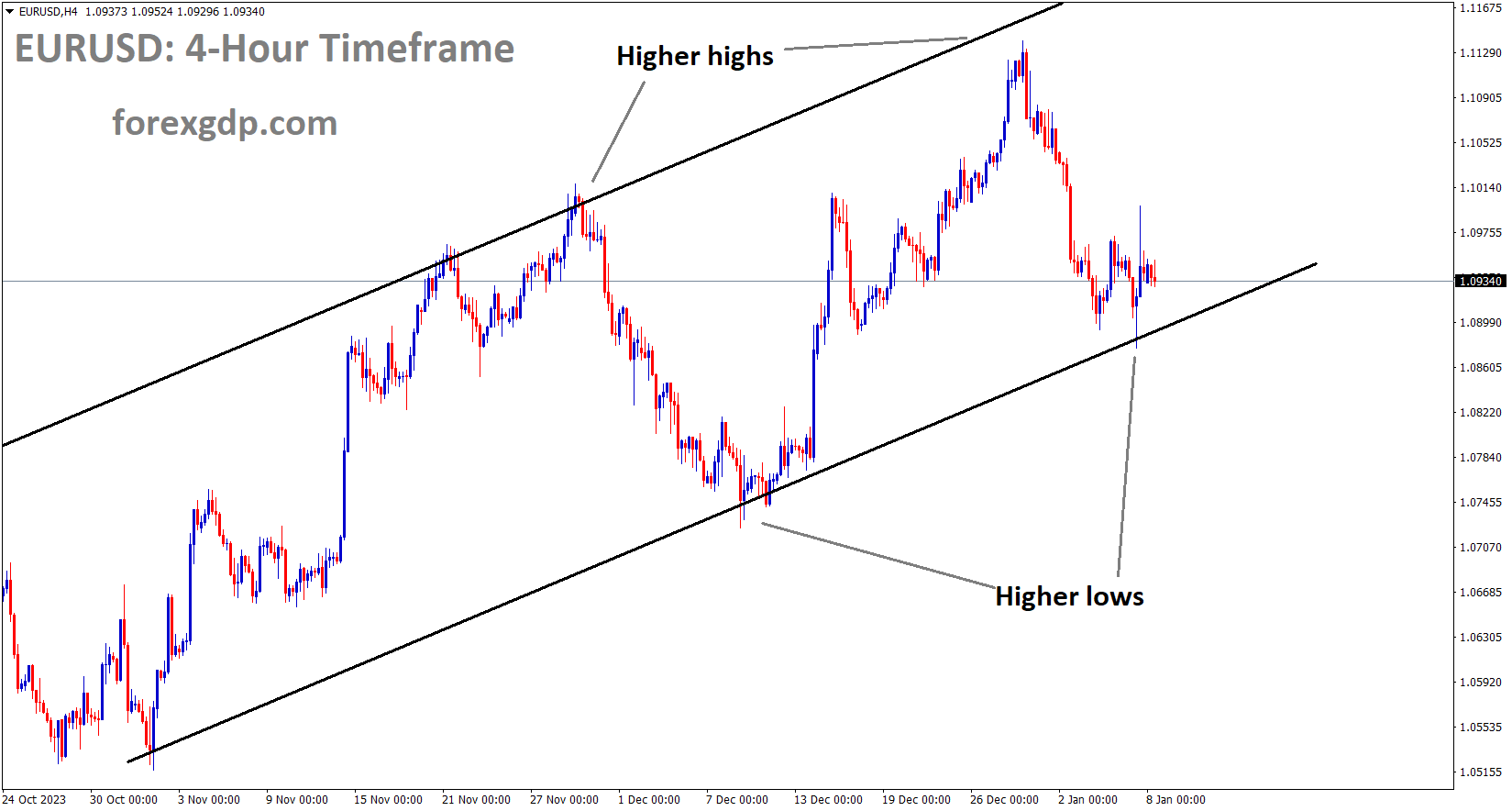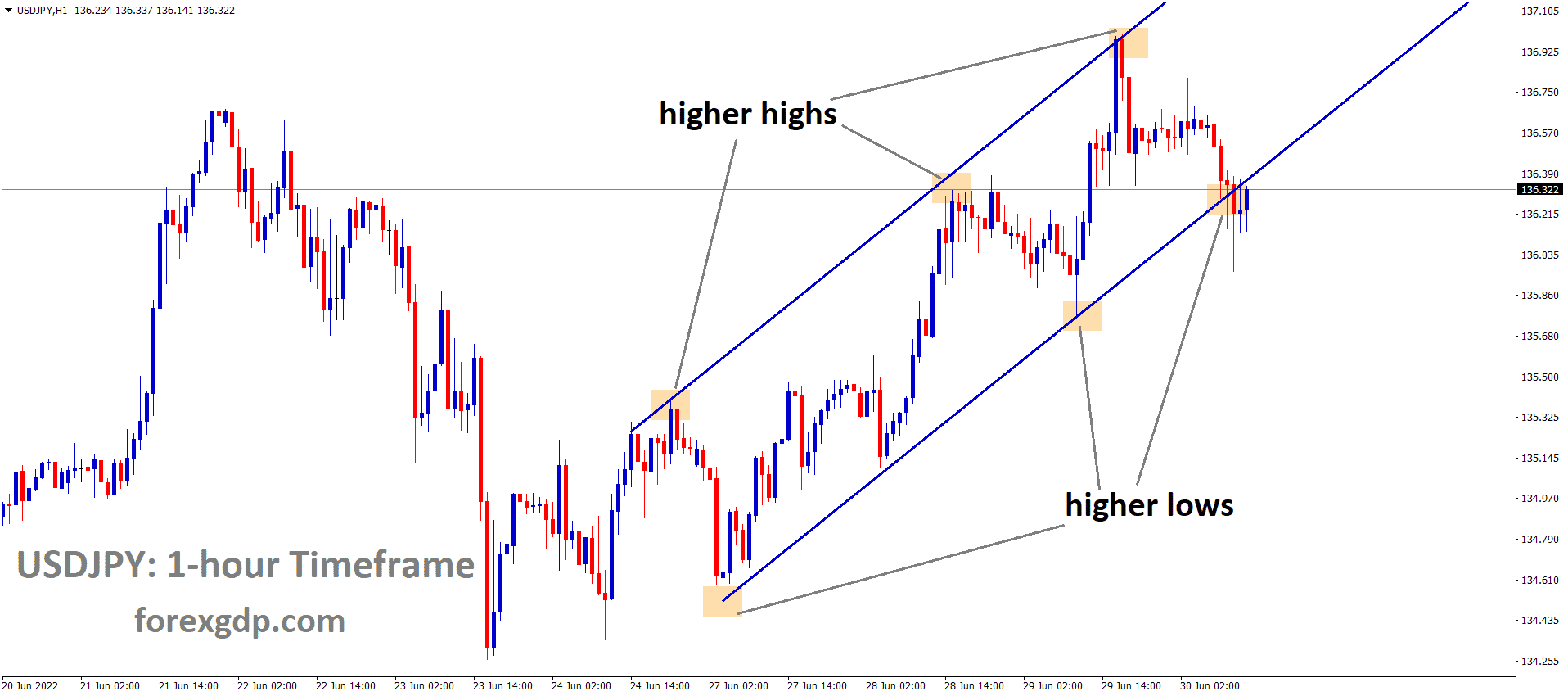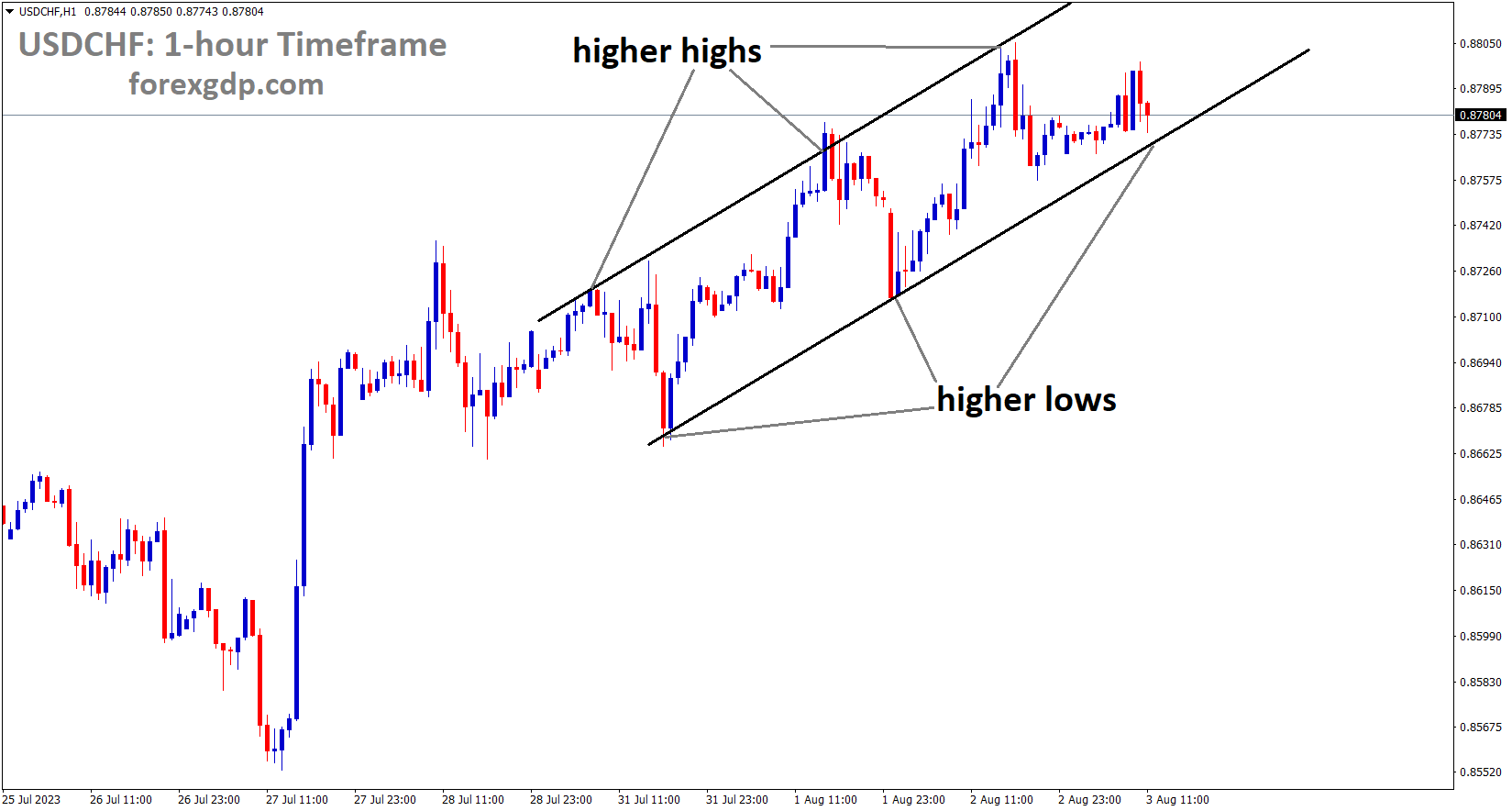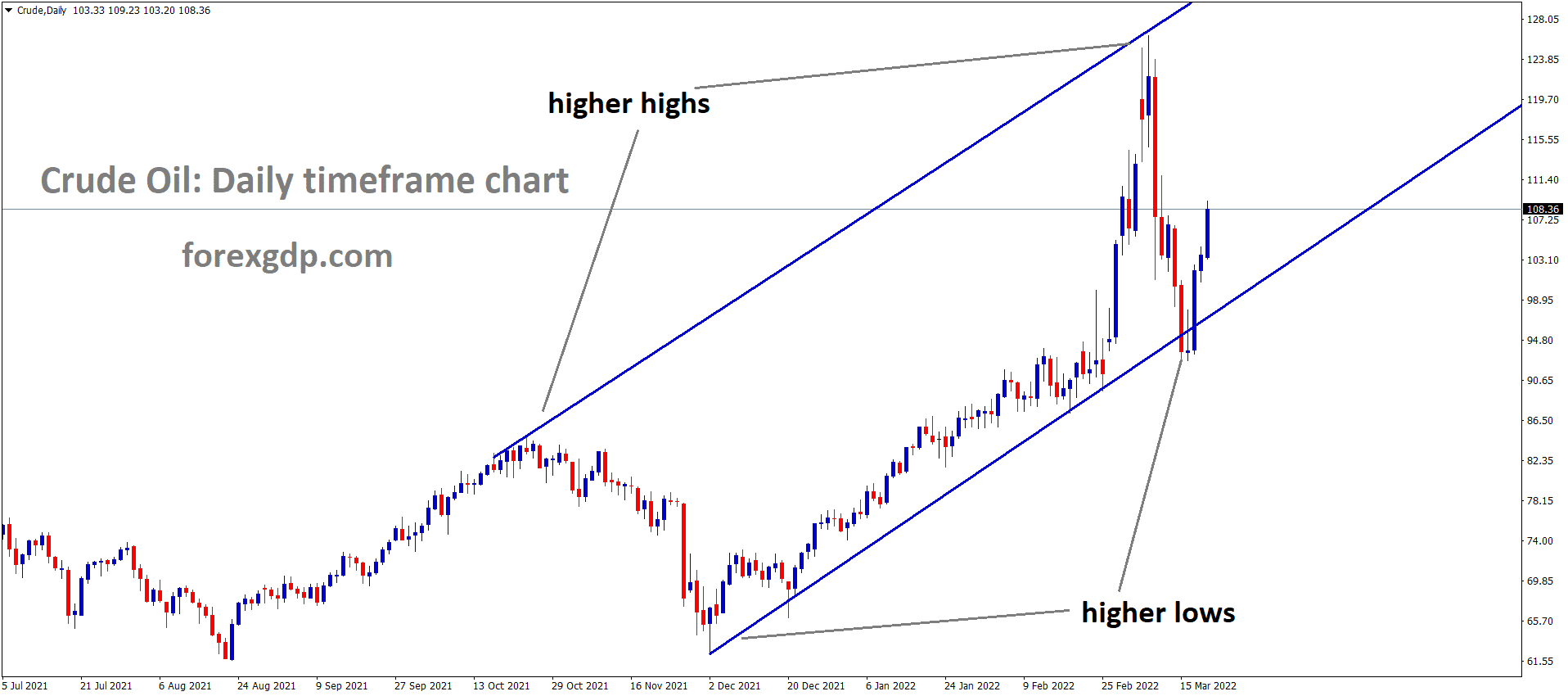GOLD Analysis:
XAUUSD Gold price is moving in the Box pattern and the market has fallen from the resistance area of the pattern
On Friday, Non-Farm Payroll data surpassed expectations, causing a decrease in Gold prices against the US dollar. The NFP data came in at 216,000 jobs added, exceeding the anticipated 170,000.
The price of gold, represented by XAUUSD, faced renewed selling pressure at the beginning of the week, edging closer to a two-week low reached after the positive US monthly employment data released on Friday. The widely watched Nonfarm Payrolls report indicated the resilience of the US labor market, giving the Federal Reserve more room to maintain higher interest rates for a longer duration. Moreover, recent hawkish comments from Fed officials have prompted investors to reduce their expectations for a more aggressive policy easing, which has supported higher US Treasury bond yields and led to capital outflows from gold, a non-yielding asset.
Nevertheless, the market still factors in a higher probability of the Fed’s first interest rate cut at its March policy meeting and anticipates a total of five 25 basis points rate cuts for 2024. This outlook puts US Dollar bulls on the defensive and could provide some support for the price of gold. Additionally, a generally cautious market sentiment could act as a tailwind for the safe-haven precious metal. Investors may also opt to wait on the sidelines and assess the US consumer inflation figures scheduled for release on Thursday before committing to new directional trades. In the absence of significant US economic data, traders on Monday will closely follow a planned speech by Atlanta Fed President Raphael Bostic for potential market cues.

Investors have dialed back their expectations for an immediate shift in the Federal Reserve’s policy stance following the release of a robust December monthly US jobs report last week. The US economy added 216,000 new jobs, surpassing the expected 170,000, while the unemployment rate remained steady at 3.7%, contrary to consensus estimates of a slight uptick to 3.8%. Furthermore, US Factory Orders exceeded expectations by growing 2.6% in November after a 3.4% decline in October. However, the Institute for Supply Management’s survey indicated a decline in the US services sector, which constitutes a significant portion of the economy. The ISM’s Non-Manufacturing Index dropped to 50.6 in December, marking the lowest reading since May, and the employment sub-component plunged to 43.3, the lowest since July 2020. Dallas Fed President Lorie Logan emphasized the importance of maintaining sufficiently tight financial conditions to prevent potential inflation resurgence, echoing the sentiments of Richmond Fed President Thomas Barkin, who expressed confidence in the economy’s path toward a soft landing and kept the possibility of rate hikes on the table. The yield on the benchmark 10-year US government bond remains above the 4.0% threshold, benefiting the US Dollar and weighing on the price of gold.
Nevertheless, market expectations still include a higher likelihood of the Fed’s first interest rate cut occurring in March and a cumulative total of five 25 basis points rate cuts for 2024. Additionally, concerns about China’s economic challenges and heightened Middle East tensions could lend some support to XAUUSD, the safe-haven asset, leading up to the release of US consumer inflation figures on Thursday. An escalation in tensions saw Lebanese militant group Hezbollah launch rockets into northern Israel in response to the assassination of senior leader Saleh al-Arouri on Tuesday. The market reaction remained limited to an agreement between House Speaker Mike Johnson and Senate Majority Leader Chuck Schumer regarding topline spending levels, breaking a deadlock to avoid a government shutdown.
SILVER Analysis:
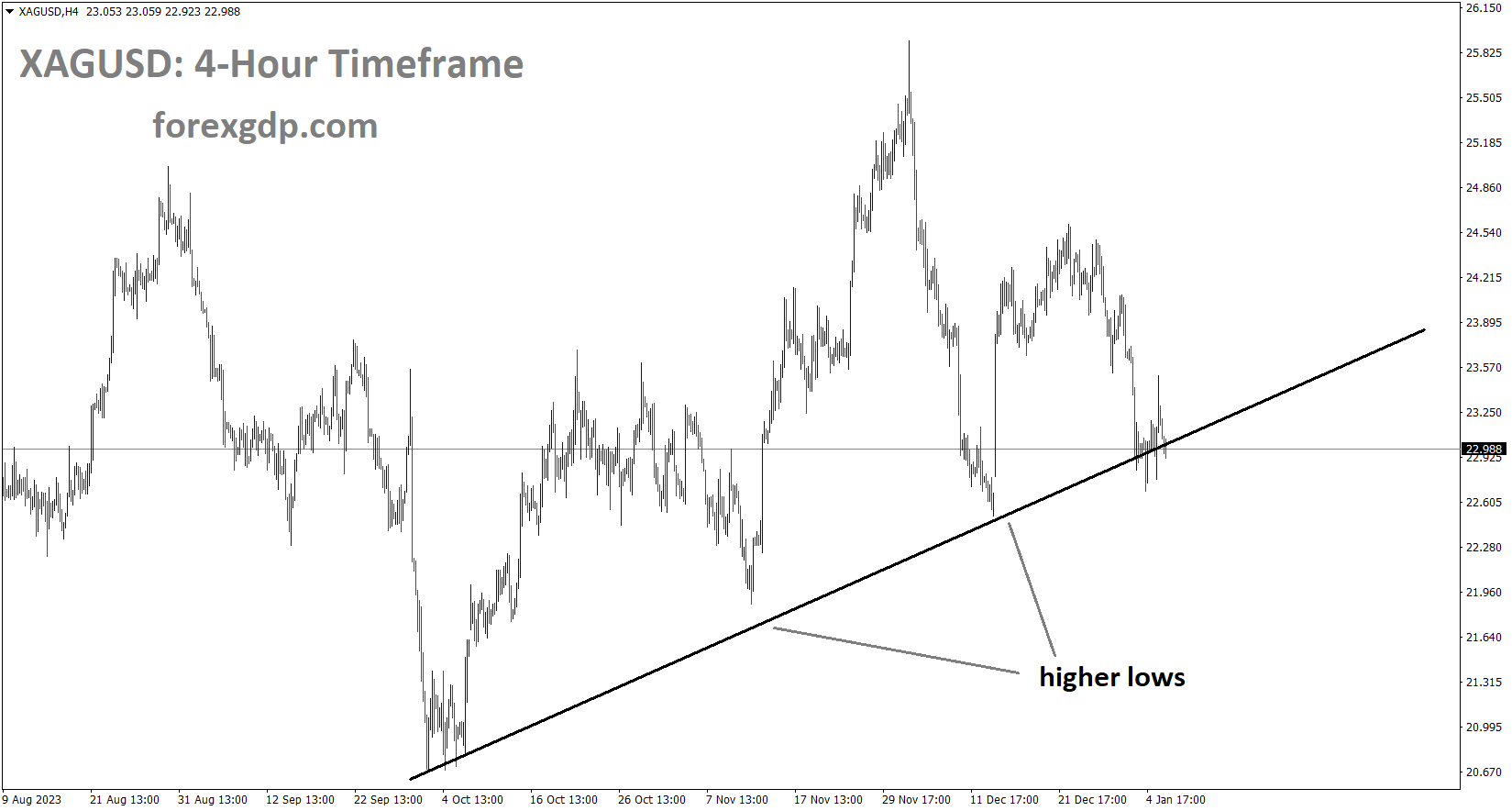
XAGUSD Silver price is moving in an Up- trend line and the market has reached the higher low area of the trend line
Lorie Logan, the President of the Federal Reserve Bank of Dallas, mentioned that a rate hike remains a possibility in response to the ongoing inflationary pressures. The tightening measures will persist in an effort to maintain inflation below the 2% threshold.
Federal Reserve Bank of Dallas President, Lorie Logan, conveyed on Saturday that the central bank may find it necessary to keep raising its short-term policy rate in order to prevent a recent decline in long-term bond yields from potentially rekindling inflation. Prematurely easing financial conditions could inadvertently stimulate demand, and if we fail to maintain sufficiently tight conditions, there is a potential risk that inflation might rebound, reversing the progress made thus far. It would be prudent to consider specific parameters to guide the decision to slow down the Fed’s balance sheet reduction.

Logan also mentioned that the labor market remains “tight,” although it continues to undergo adjustments. The financial system, on the whole, possesses more than enough bank reserves and liquidity, albeit no longer at levels considered super abundant. While inflation is in a significantly better position compared to the same period last January, the Fed’s mission is not yet complete. As a result, Logan suggested that the pace of asset runoff should be reduced, particularly as the Fed’s overnight reverse repurchase balances approach a lower level.
USDCHF Analysis:
USDCHF is moving in the Descending channel and the market has reached the lower high area of the channel
Today, we are expecting Swiss CPI data for December, with a projected year-on-year increase of 1.5%, compared to the previous month’s rate of 1.4%.
The unexpectedly positive labor data in the United States from Friday has weakened the case for rate cuts by the Federal Reserve. According to the CME Fed watch tool, traders are now estimating a probability of over 60% for rate cuts in the upcoming March meeting.

In December, US Nonfarm Payrolls experienced robust growth, adding 216K jobs compared to 173K in November, surpassing the market consensus of 170K. Additionally, Average Hourly Earnings increased by 0.4% month-on-month, exceeding the estimated 0.3%, and the annual figure for December reached 4.1% year-on-year, up from the previous 4.0%, surpassing the expectation of 3.9%.
Investors will closely watch the Swiss Consumer Price Index for December, set to be released later on Monday. The annual CPI is anticipated to show a 1.5% YoY increase, up from the previous reading of 1.4%, while the monthly CPI is expected to remain unchanged at -0.2% MoM. The highlight of this week will be the release of US inflation data on Thursday. Market participants are forecasting that the headline Consumer Price Index will reflect a 3.2% YoY increase, while the Core CPI is expected to ease slightly from 4% to 3.8% YoY.
EURUSD Analysis:
EURUSD is moving in an Ascending channel and the market has reached the higher low area of the channel
In November, German factory orders increased by 0.30%, rebounding from a 3.8% contraction in October. However, it is worth noting that factory orders typically experience a yearly decline of 4.4%.

According to the Bundesbank’s report on Monday, Factory Orders in Germany increased by 0.3% in November compared to the previous month. This growth follows a significant 3.8% contraction in October and fell short of market expectations, which had anticipated a 1% rise. On an annual basis, Factory Orders experienced a decline of 4.4%. In other economic indicators for Germany, Imports and Exports both saw positive monthly growth, with Imports expanding by 1.9% and Exports by 3.7%.
GBPUSD Analysis:
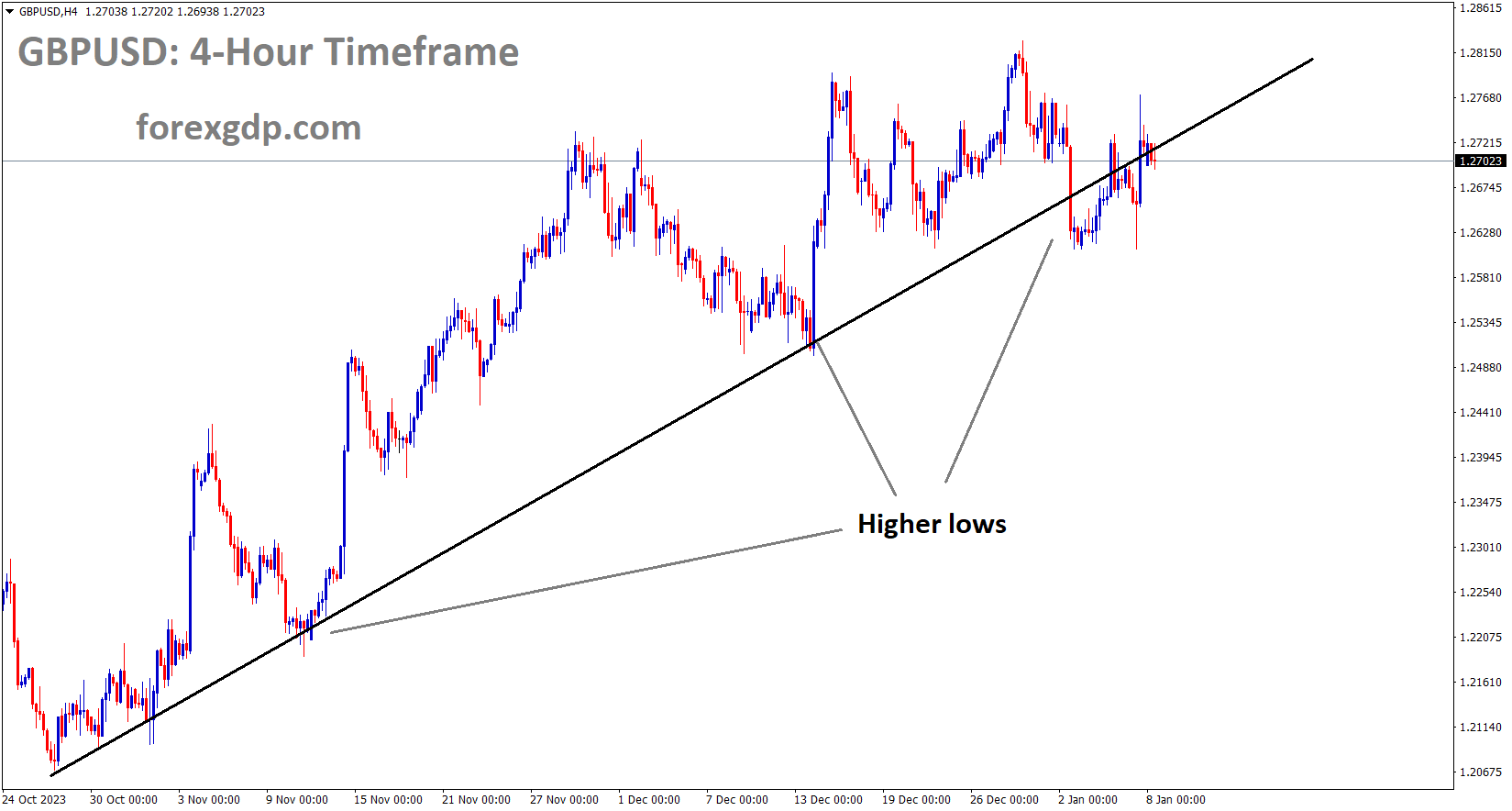
GBPUSD is moving in an Up- trend line and the market has reached the higher low area of the trend line
The UK economy is on the brink of a technical recession due to the GDP decline in the third quarter. If the fourth quarter also reports a negative GDP, the UK will officially enter into a technical recession. Elevated interest rates and increased inflation contribute to a pessimistic outlook for the UK economy.
The Pound Sterling has shown significant strength against the US Dollar, as market risk appetite improved, despite the release of positive US economic data. The GBPUSD pair has continued to strengthen, even though all components of the US Nonfarm Payrolls data for December exceeded expectations. It appears that the robust labor demand in the US had already been factored in by market participants. However, there are challenges ahead for Bank of England policymakers, as they grapple with the difficult task of navigating between deepening recession risks in the UK economy and persistently high underlying inflation.

The likelihood of a technical recession in the UK is elevated, given the contraction observed in the third quarter and the expected stagnation in the final quarter. Additionally, recent PMI data indicates ongoing challenges in the manufacturing sector due to elevated interest rates. The outlook for the GBPUSD pair has dimmed, as US employment indicators could reshape guidance on interest rates by the Federal Reserve.
Despite the stronger-than-expected official Employment data for December in the United States, the Pound Sterling has staged a robust recovery. US employers added 216,000 workers, surpassing the 199,000 jobs created in November, albeit with more modest job gains in December. The Unemployment Rate remained steady at 3.7%, contrary to expectations of a slight increase to 3.8%. Average Hourly Earnings maintained a steady pace of 0.4%, with annual wage growth at 4.1%, up from the previous 4.0%. Investors had anticipated a softening in labor cost data to 3.9%. Bets favoring a rate cut by the Federal Reserve in March have significantly receded. The US Dollar Index declined sharply after reaching a fresh three-week high at 103.00.
GBPCHF Analysis:
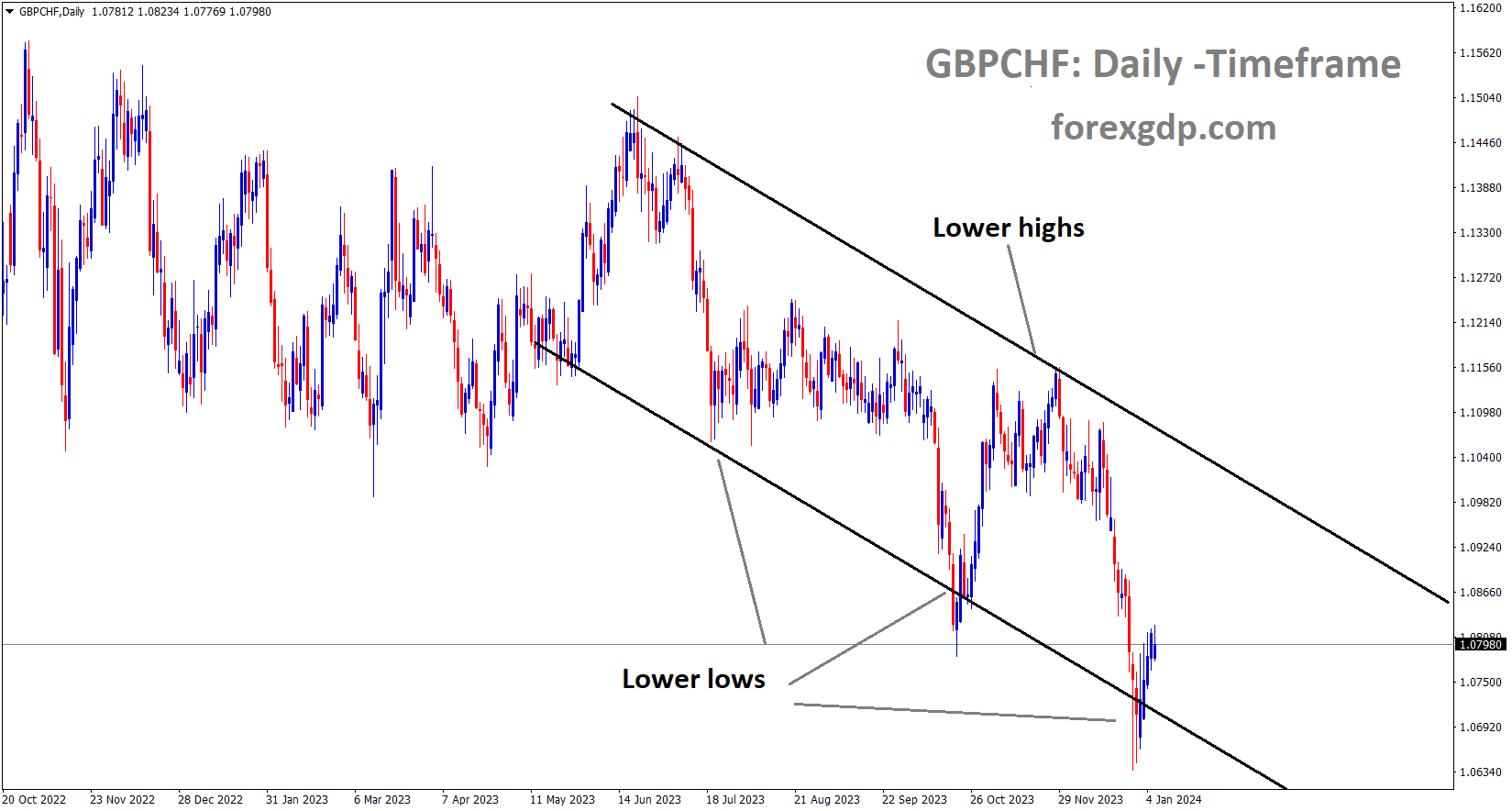
GBPCHF is moving in the Descending channel and the market has rebounded from the lower low area of the channel
The Pound Sterling continues to face pressure as investors anticipate a mild recession in the United Kingdom, with the economy contracting by 0.1% in the third quarter of 2023.
Bank of England policymakers are in a delicate balancing act, weighing the potential benefits of an early rate cut to avert a recession against the risk of fueling inflationary pressures. While the UK’s manufacturing sector remains in contraction due to challenging conditions both domestically and abroad, the Services PMI, which measures activity in the services sector, expanded at the fastest pace since June. S&P Global reported a December Services PMI reading of 53.4, exceeding expectations of 52.7 and the previous reading of 50.9. The significant increase in client demand, driven by hopes of lower borrowing costs and economic recovery in 2024, accelerated growth in service activities according to S&P Global.
GBPCAD Analysis:
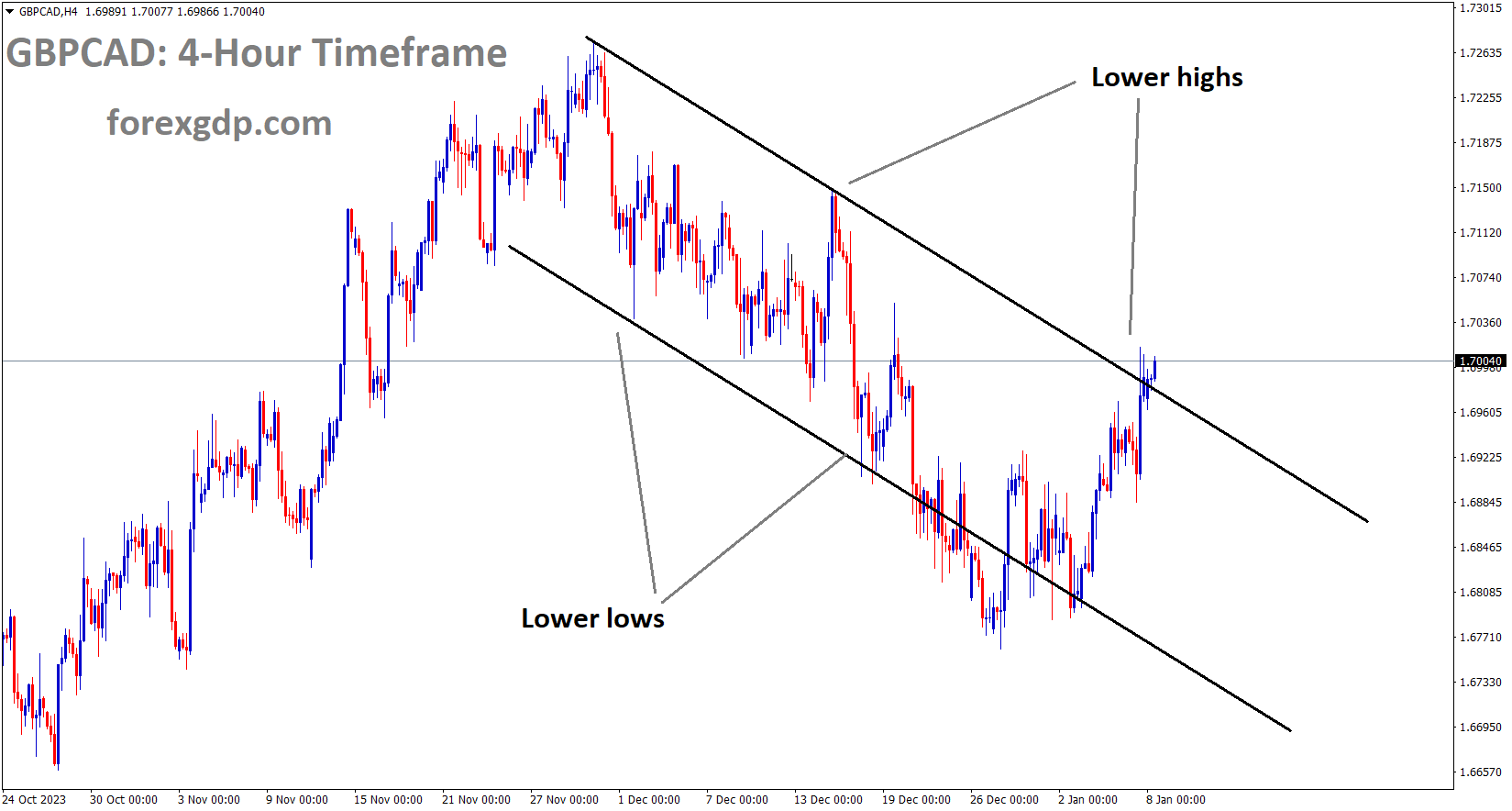
GBPCAD is moving in the Descending channel and the market has reached the lower high area of the channel
The Canadian jobs report from last Friday revealed fewer job additions than anticipated, with only 0.1K jobs created in December compared to the expected 13.5K.
The Canadian Dollar initially dropped to a new low for the week against the US Dollar but later surged to a three-day high as market sentiment fluctuated in response to a robust US Nonfarm Payrolls report that exceeded market expectations. Canada’s labor market appeared somewhat restrained, with a job addition figure that fell below expectations, and wage growth continued to accelerate, reaching a two-year high.
However, the forecasts for Canadian Net Change in Employment were far from accurate, as Canada added only 0.1K new jobs in December, compared to the predicted decline from 24.9K to 13.5K. Canadian December Ivey PMIs appeared positive in the seasonally-adjusted figure, increasing from 54.7 to 56.3. However, cyclically-adjusted factors played a significant role, as the non-seasonally adjusted PMI dipped into contractionary territory at 43.7, marking a 12-month low.
And According to a Reuters survey, OPEC+ members boosted their oil production by 70,000 barrels per day in December, resulting in a total output of 27.88 million barrels per day for the month. As a result of this news, oil prices declined to $73.00 per barrel.

During the Asian session on Monday, the West Texas Intermediate price retraced its recent gains and was trading lower, hovering around the $73.00 per barrel mark. Several factors are contributing to this decline in crude oil prices, with one key factor being the price cuts initiated by the leading oil exporter, Saudi Arabia. Additionally, an increase in oil production by the Organization of the Petroleum Exporting Countries (OPEC) and its allies has added downward pressure on oil prices. According to a Reuters survey, their combined output rose by 70,000 barrels per day (bpd) in December, reaching a total of 27.88 million bpd. Notably, Iraq and Angola accounted for the most significant increases, contributing 60,000 bpd to this rise. Furthermore, Nigeria reported an uptick in its crude oil shipments during the same period. These increases in oil production counteract the ongoing production cuts by Saudi Arabia and other members of the OPEC+ alliance. The survey findings also indicate that Saudi Arabia has slightly reduced its production, bringing it below 9 million bpd, while continuing a voluntary 1 million bpd output cut. These actions are part of Saudi Arabia’s efforts to influence global oil prices.
Adding to these dynamics, Saudi Arabia made an announcement on Sunday about reducing the February Official Selling Price of its flagship Arab Light crude to Asia, marking the lowest level in 27 months. Furthermore, last week, the Iran-backed Houthis escalated concerns regarding oil supply by launching two anti-ship ballistic missiles at a container ship in the southern Red Sea while it was en route to Israel. This provocative action has heightened geopolitical tensions in the region, particularly concerning maritime routes. US Secretary of State Antony Blinken issued a warning regarding the Gaza conflict, expressing concern that without concerted peace efforts, the conflict could potentially spread across the broader region.
GBPJPY Analysis:
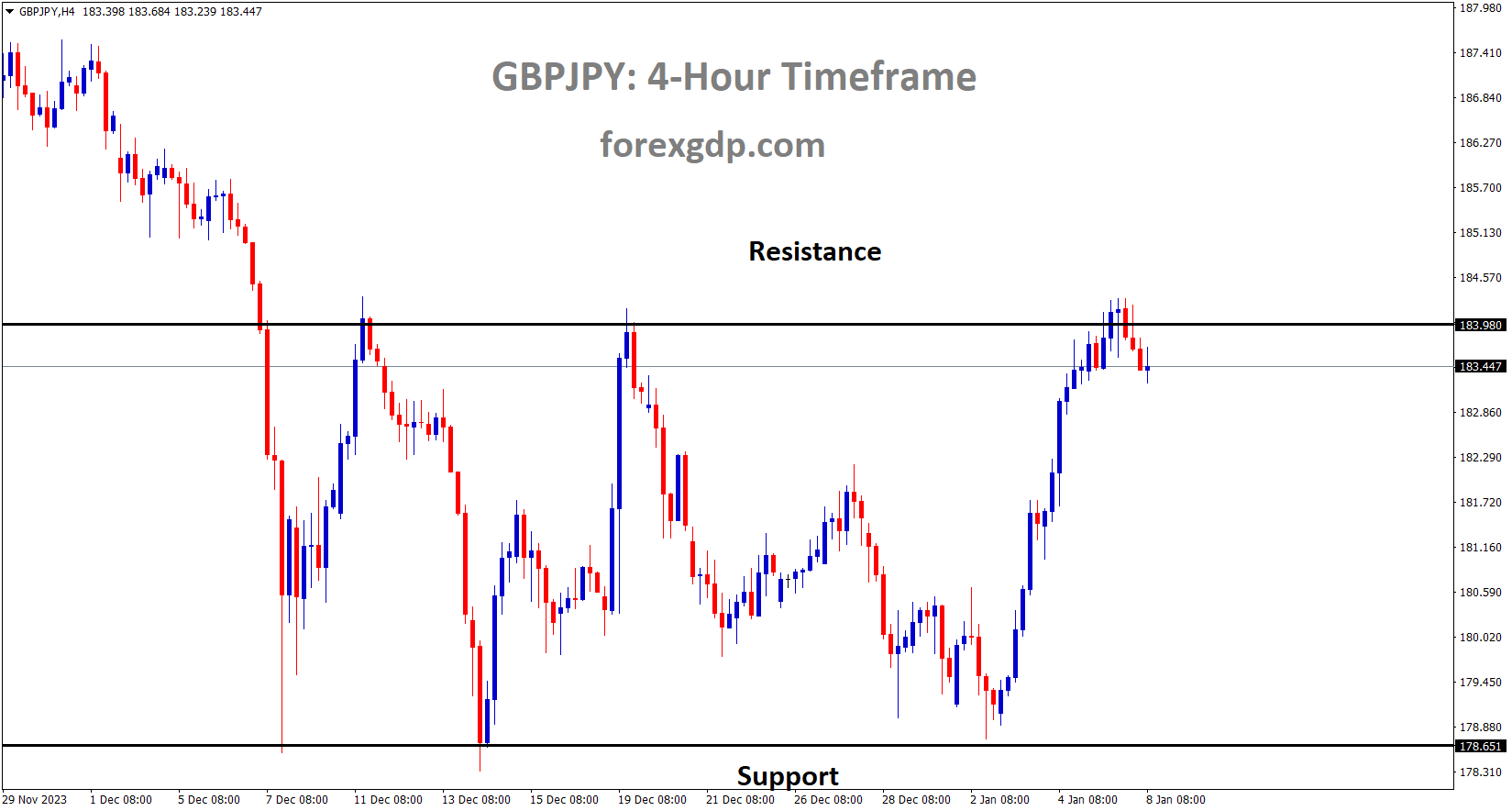
GBPJPY is moving in the Box pattern and the market has fallen from the resistance area of the pattern
The Japanese yen rebounded from its low levels as expectations for a rate hike diminished following an earthquake in Central Japan. Economists are now foreseeing the continuation of negative rates until the first half of 2024 as a more likely scenario.
Amid China’s economic challenges and geopolitical risks, the decreasing likelihood of a more aggressive policy easing by the Federal Reserve is impacting investor sentiment and favoring the traditional safe-haven currency, the Japanese Yen. However, the JPY’s further gains are constrained by growing expectations that the Bank of Japan will not abandon its negative interest rates policy during its January 22-23 meeting, especially following the recent earthquake in Japan.
The Japanese Yen experienced a significant decline of over 2% last week, marking its worst weekly performance since June 2022. This decline is attributed to diminishing hopes for an immediate change in the Bank of Japan’s policy later this month.
AUDUSD Analysis:
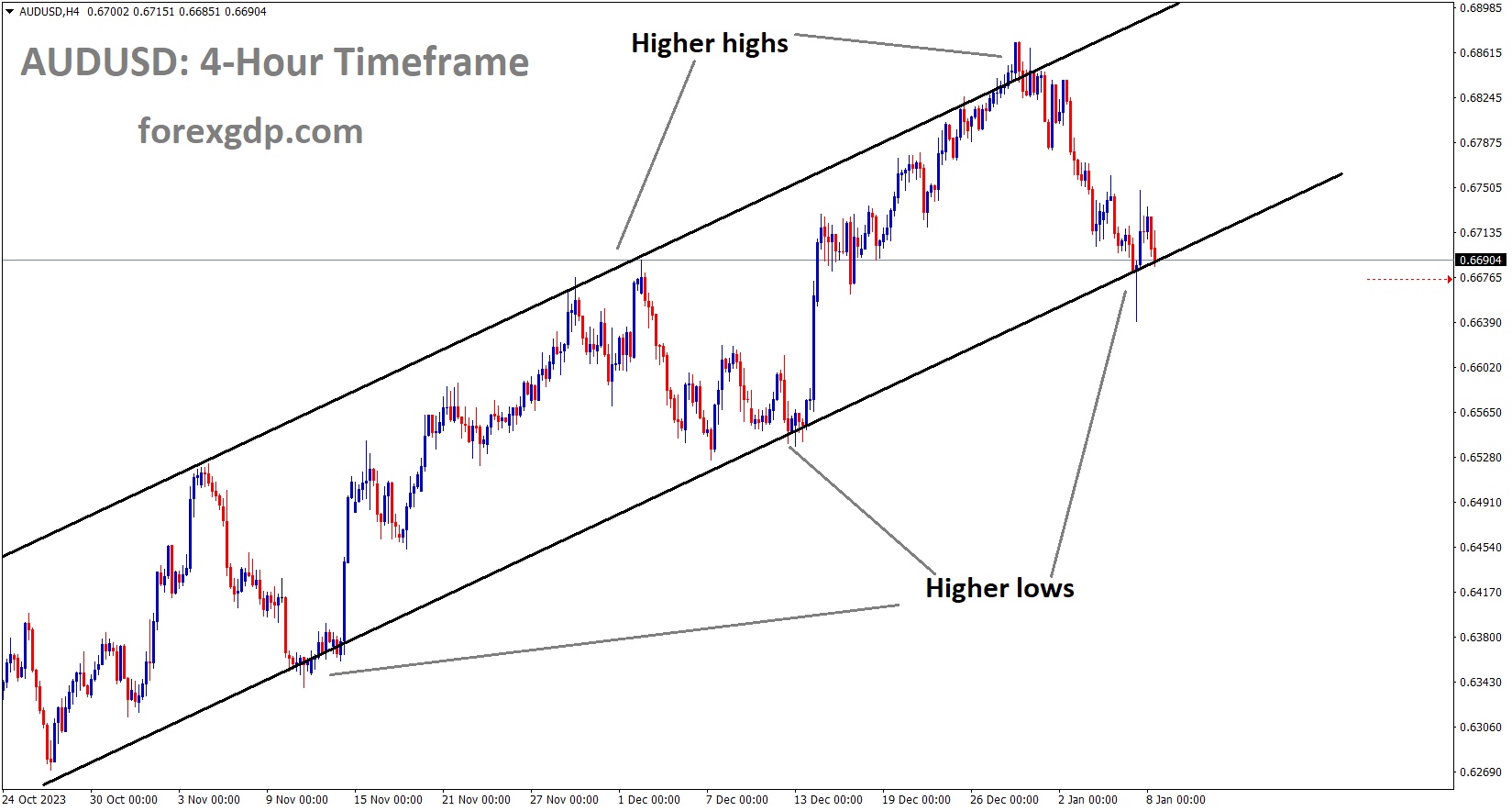
AUDUSD is moving in an Ascending channel and the market has reached the higher low area of the channel
Tomorrow, we anticipate the release of Australian retail sales data for November, with an expected increase of 1.2% following a 0.20% decline in October.
The AUDUSD pair witnessed significant volatility, largely influenced by mixed economic data from the United States. Despite a strong US employment report, concerns lingered regarding weaker business activity in the services sector, leading investors to approach the economic outlook with caution. On Tuesday, Australia is set to release Retail Sales data for November, expected to show a 1.2% increase compared to October’s 0.2% decline. This release could influence Reserve Bank of Australia (RBA) policymakers to maintain elevated interest rates for an extended period. However, recent data from the Judo Bank Purchasing Managers Index revealed a contraction in business activities in both the services and manufacturing sectors, highlighting the vulnerability of the Australian Dollar. In addition to this, Chinese wealth manager Zhongzhi Enterprise Group’s bankruptcy liquidation, facing a massive $64 billion in liabilities, raised concerns about potential contagion from the broader property debt crisis into the financial sector. This event is likely to have a negative impact on the Aussie Dollar , given the close economic ties between China and Australia.
The US Dollar Index has been moving sideways with a slight downward bias, possibly influenced by the decline in short-term yields on the 2-year US Treasury bond. On Friday, the US Dollar experienced fluctuations between gains and losses, driven by mixed US data. The US Bureau of Labor Statistics reported a positive development in the job market, with Nonfarm Payrolls rising to 216K in December, surpassing the November figure of 173K and beating the market expectation of 170K.

Additionally, Average Hourly Earnings improved to 4.1% from the previous 4.0%, while the monthly index remained steady at 0.4%, surpassing the expected 0.3% decline. However, the Institute for Supply Management indicated a slowdown in the services sector in December, with the Services Purchasing Managers Index coming in at 50.6, below the expected 52.6 and the previous 52.7. The Services Employment Index also declined to 43.3 from the previous 50.7. Thomas Barkin, President of the Federal Reserve Bank of Richmond, noted a steady softening pattern in the US labor market, suggesting that a reacceleration of the labor market is unlikely at this point.
Federal Reserve Bank of Dallas President Lorie K. Logan provided insights on Saturday, suggesting that a rate hike should not be ruled out, considering the recent easing in financial conditions. She emphasized the importance of avoiding premature easing, which could stimulate demand, as maintaining sufficiently tight financial conditions is crucial to managing the risk of inflation picking back up and potentially reversing progress. In Australia, the Judo Bank Services PMI reported a reading of 47.1, falling short of market expectations for it to remain stable at 47.6. The Composite PMI decreased to 46.9 from the previous figure of 47.4. Australia’s Judo Bank Manufacturing PMI also indicated a modest contraction in manufacturing activity, declining to 47.6 in December from the previous reading of 47.8. On the other hand, China’s Caixin Services PMI rose to 52.9 in December, surpassing the expected 51.6 and the previous 51.5.
In the United States, the ADP Employment Change data showed the addition of 164K new positions, surpassing the previous figure of 101K and the market expectation of 115K. Additionally, US Initial Jobless Claims for the week ending on December 29 displayed positive signs for the labor market, decreasing to 202K from the previous 220K, beating the anticipated 216K. However, the US S&P Global Composite PMI for December reported a minor dip in business activities, registering a reading of 50.9 compared to the market consensus of a steady 51.0.
NZDUSD Analysis:
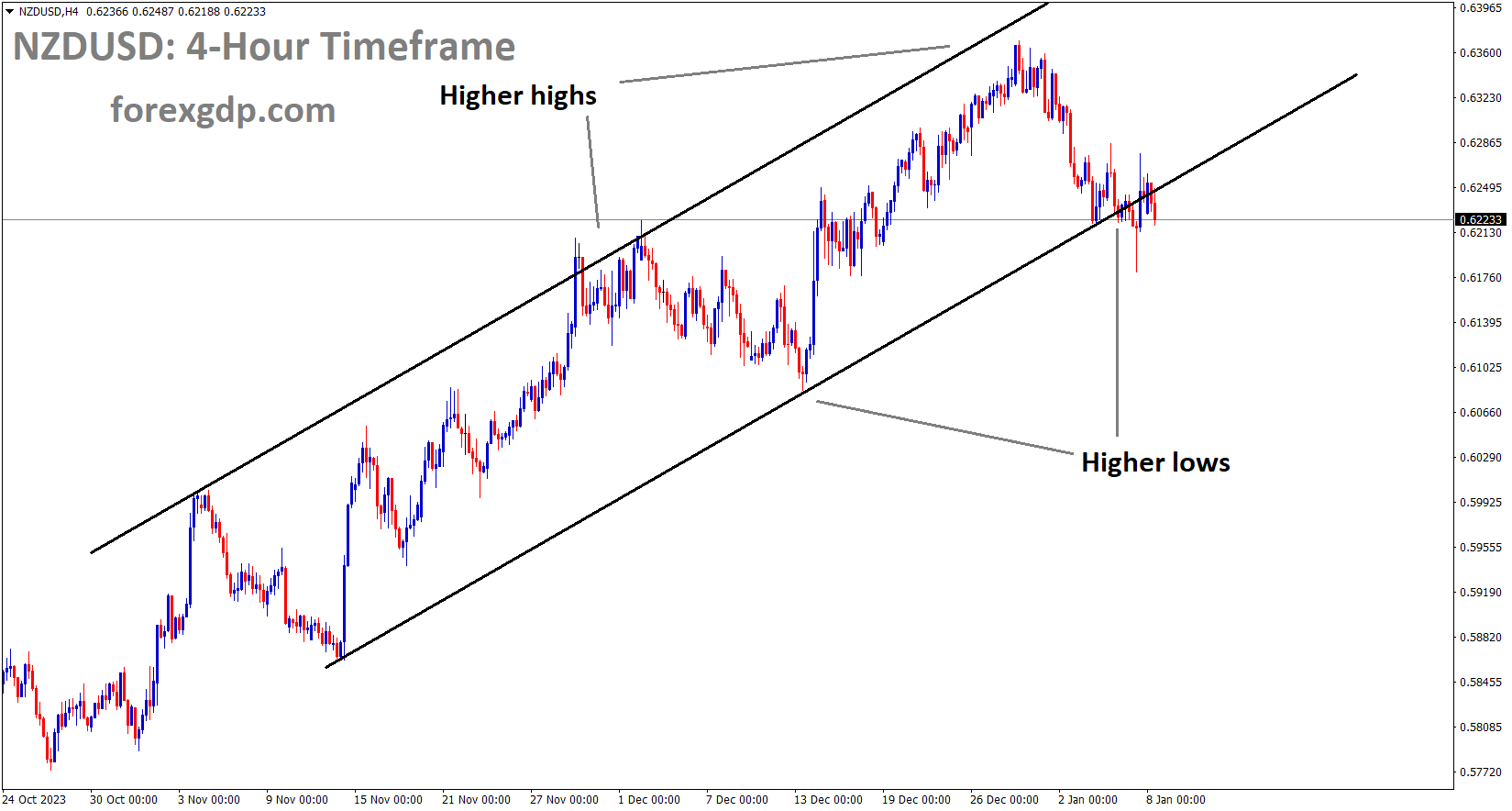
NZDUSD is moving in an Ascending channel and the market has reached the higher low area of the channel
Last week, Chinese economic data showed positive figures, and this week we are looking forward to the release of CPI and PPI data for China. Additionally, New Zealand’s building permits data is also scheduled for this week.
The release of US inflation data through the Consumer Price Index on Thursday may offer indications of further evidence regarding price pressures. The positive US labor data from Friday has diminished the case for potential rate cuts by the Federal Reserve . Traders are now positioning themselves for the possibility of five or six rate cuts by the Fed throughout the year.

Currently, they are pricing in a 75% likelihood of the first cut occurring in March, a change from the fully priced-in status observed at the end of the previous year. According to the US labor data released on Friday, US Nonfarm Payrolls saw an increase of 216,000 jobs in December, up from 173,000 in November, surpassing the market consensus of 170,000. Additionally, the Unemployment Rate remained steady at 3.7%. Average Hourly Earnings also demonstrated strength, rising by 0.4% month-on-month, surpassing the expected 0.3%. The annual figure for December stood at 4.1% year-on-year, compared to 4.0% in the previous reading, exceeding the consensus estimate of 3.9%.
Turning our attention to the New Zealand Dollar, the recent stronger-than-expected economic data from China has boosted the NZD, which is often viewed as a proxy for China’s economic performance. This development has provided tailwinds for the NZDUSD currency pair. Traders will closely monitor upcoming Chinese data scheduled for release later this week, including the December Chinese Producer Price Index (PPI) and Consumer Price Index. Positive data could further support the NZD against the US Dollar. In the lead-up to the US CPI reports on Thursday, market participants will also focus on New Zealand Building Permits data on Tuesday. Finally, on Friday, attention will shift to the Chinese CPI and PPI figures, offering traders valuable insights and potential trading opportunities involving the NZDUSD pair.
Don’t trade all the time, trade forex only at the confirmed trade setups.
Get more confirmed trade setups here: forexgdp.com/buy/

